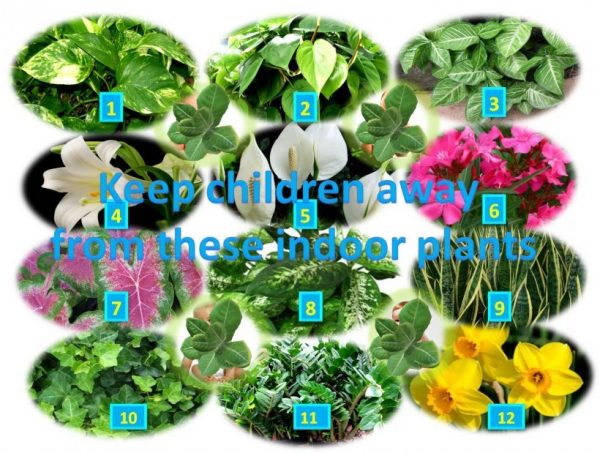
Poisonous Indoor Plants & Kids Safety
We decorate house various ways. Most time people love to include indoor plants in their decoration. Because indoor plants are beautiful and makes house more livable and warming. There are many indoor plants available in horticulture division. Did you know that many indoor plants are not safe for kids and pets? Sometimes the plant labels (if available) will describe the nature of plant – how to grow and how toxic the plant is.
Many times we might be kept in dark because of no such information will be available or we may just borrow cuttings from friend’s house. The most common plants that we grow indoor that are toxic for both kids and pets are listed below.
Poisonous plants contain chemicals that can cause severe reactions – allergy to children and if consumed can be fatal too .Precautions needed when you select indoor plants to decorate house especially if you have young children (and pets).
The 12 poisonous plants are listed below are commonly used as indoor plants.
- Philodendron: How toxic? Mildly: (Philodendron selections) : No other group of plants is as widely used indoors as philodendrons, but they are poisonous to humans and pets. Eating them can cause burning and swelling of lips, tongue, and throat; vomiting; and diarrhea.
- Pothos: How toxic? Yes: (Epipremnum aureum): A close relative of philodendron, pothos is just as easy to grow, but unfortunately causes the same symptoms of philodendron if ingested.
- Arrowhead: How toxic? Moderately : (Syngonium podophyllum) The leaves are constantly shedding and being regrown, so even if this plant is out of reach, it is a good idea to check often for fallen leaves. Humans and animals: Irritated skin, stomach upset, vomiting.
- Easter Lily: How toxic? Moderately: (Lilium longiflorum): Cats have been known to suffer serious damage after eating Easter lilies. Eating small amounts of any part of the plant can lead to a cat’s death from kidney failure if not treated by a veterinarian within 18 hours. The plant is not poisonous to children, but they can choke on pieces of it.
- Peace Lily: How toxic? Yes: (Spathiphyllum selections): A popular low-light houseplant, the peace lily is toxic only if large quantities of the leaves are eaten. Burning and swelling of lips, mouth, and tongue, difficulty speaking or swallowing, vomiting, nausea, and diarrhea.
- Dieffenbachia: How toxic? Moderately: (Dieffenbachia selections): This popular houseplant grows in low-light conditions. It’s earned one of its common names, dumb cane, because of the symptoms that occur when it’s eaten. The sap causes the tongue to burn and swell, enough to block off air to the throat. It can be fatal to both humans and pets if ingested in large amounts.
- Oleander: How toxic? Extremely: (Nerium oleander) All parts of oleander, a popular indoor flowering shrub, are extremely poisonous. Wear gloves and wash your hands when pruning and taking cuttings to be sure you don’t accidentally ingest the sap. It can be fatal if eaten.
- Caladium: How toxic? Extremely: South American bulb plant with long-lasting foliage. They are popular as houseplants or for outside landscaping. All parts of the Caldadium are considered toxic to humans and animals. Symptoms after ingestion can include- painful burning and swelling of the mouth, tongue, lips and throat, difficulty breathing, speaking, and swallowing, and possible blocked airways that can lead to death.
- Mother-In-Law’s Tongue: How toxic? Low – Sansevieria species –The foliage variegated green with hints of white, yellow, and silver. The toxicity level is low, producing short-lasting symptoms such as mouth pain, salivation, and some nausea. In rare instances, it can produce a dermatological reaction, but is mainly toxic only if ingested.
- Ivy: How toxic? Mildly: (Hedera helix): Large quantities of ivy must be ingested to cause serious problems, but all parts of English ivy can cause symptoms that include skin irritation, burning throat after eating the berries, fever, and rash.
- ZZ plant: How toxic? Mildly: (Zamioculcas zamiifolia) : They are commonly known as evergreen plants and require very little water once a while. The drought-tolerant ZZ plant is a wonderful addition to low-light situations in homes and offices, but all parts of this plant are poisonous. Keep it away from children and pets, and wash your hands or wear gloves if you need to handle it.
- Daffodils : How toxic? Moderate: (Narcissus selections) : Many spring bulbs, including hyacinths and daffodils forced for indoor blooms, are toxic if eaten by humans or pets. Eating the bulbs (which can be mistaken for shallots or onions) can cause intense stomach problems, high blood pressure, irregular heartbeat, and even death.
If you ask then which safe indoor plants are, there are safe indoor plants available in nursery. Look for these below mentioned plants.
- Christmas Cactus
- Coleus
- Boston Fern
- Spider Plant
- Jade Plant
- African Violets
- Miniature rose
- Wandering Jew
What precautions one should take with indoor plants?
Children and pets should be kept away from the indoor plants. Take as much as care as possible. Teach children not to touch the plants.
- Label plants with the plant name and mention whether plant is toxic or not.
- Wear gloves while handling plants.
- Teach children not to touch plants- keep the plants away where children do not play or touch plants
- Trim plants to prevent children and pets from accessing vines.
- If possible hand plants up or keep them on plant stands.
- Water plants regularly and remove any dead leaves or stem.
- If you have pets, keep a separate bowl of water form them so that they do not drink from pot trays.
Source: www.werindia.com
Author: Sumana Rao | Posted on: January 17, 2020
« When to introduce spices and herbs to kids How to talk to kids about coronavirus outbreak? »




















Write a comment